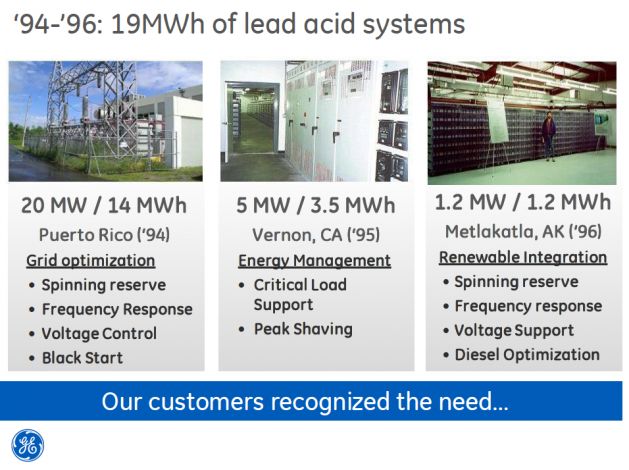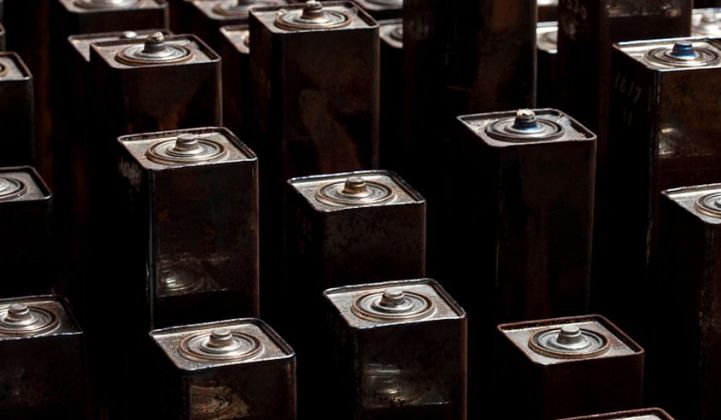Pratima Rangarajan, General Electric's GM of product development and marketing for energy storage, kicked off this week's Energy Storage North America event in San Diego, Calif.
"If you look at grid energy storage and compare it to its brothers and sisters -- other technologies and products on the grid -- it's just emerging. It's a baby," she said. Rangarajan attributed the emergence of energy storage to the fact that "cost has come down by about 3X."
Rangarajan showed a slide that plotted technology deployment over time for wind and solar and compared it to storage. She noted that there will be "almost 500 megawatts installed this year."
She added, "It's all due to the pioneers in this field. This starting up a new business model, starting up a new market, required imagination and courage of the many people in this room that have been sticking to this product for 20 years, 10 years, five years, even while our companies and the general businesses around said it would never be possible."

Rangarajan suggested that storage's initial forays into the market were not undertaken by startups. "What's interesting about this start, is that it wasn't just startup companies that drove it. It was the people that nobody would have ever expected. It was the utilities behind it, the utilities that are speaking today and spoke yesterday. It is the policymakers. It is the innovators and the champions all around this room."
"At GE, we understand scale"
"We are ready to go to the next stage, which is the scaling stage," she said, adding, "I just want to point out, as I show the brethren in wind and solar, you don't even see the emergence scale, their emergence on this chart. You can't even plot it. For us, we're just there, we're just at the emergence."
"The next step for us is to scale. If we look at wind, when they went through a 5X drop in cost during the scale-up period, the number of annual installed megawatts went up 50X, fiftyfold. Solar was even faster. It was a 6X drop in cost with about a 70X increase in solar. I would even posit that energy storage will be faster than the two of them. Energy storage is not just a generator of electricity; it can do so many things, it can provide so many services on the grid -- services that we've been looking for an efficient way to deliver all these years."
GE's Rangarajan said, "Within the grid ecosystem we work at a terawatt scale." The GE gas fleet is about a terawatt. She continued, "Add to this a wind fleet of 40+ gigawatts, where we add another 5 gigawatts a year. I haven't even mentioned nuclear or all the other services that GE provides on the grid. To us, energy storage is just a simple natural extension. It is what is going to harden the services we already provide on the grid, but also provide the reliability and other services we've needed for a long time but did not have the product" to fulfill those needs.
Energy storage ancient history (the 1990s)
"I'm going to hark back to some pioneers and innovators in the early '90s, where they actually recognized the need for a storage solution to do what we are talking about today. Grid optimization, spinning reserve, frequent response, voltage control, black start, pink shading -- nothing differs. Same services. This is the 1990s, and we had some customers that already recognized this need. Remember, this was a time before lithium-ion batteries were ubiquitous in the world. A time when early laptops were out and [used] NiCad and nickel-metal-hydride batteries. This was a time when the 'renewables future' was just a bad word for a lot of people."
Still, "In the 1990s, GE put about 19 megawatt-hours of lead-acid systems in the ground for our customers. Fast-forward, the technology wasn't there, the lead acid wasn't good enough, we couldn't [use it as the basis for] cost-effective services. Fast-forward to 2007, GE is wondering what are we going to do, we do need these services on the grid. At that time, in the 1990s, there was no lithium-ion. You come to 2007, lithium-ion costs about $2,000 per kilowatt-hour. We knew this wasn't economical for our customers, so we went out and bought a battery, which we called Durathon. It was nickel-metal-hydride, and we started to drive its cost down, and put about 40 megawatt-hours of these systems in the grid all over the world."
"As we proceeded through this, we started realizing just how important these services were to the grid, and to our customers, but at the same time, the lithium-ion revolution started," Rangarajan continued.

Fast-forward to energy storage in 2016
GE installed about 90 megawatt-hours of energy storage from 2007 to 2015. "Now, as we look at 2016, in one year, we're going to put in about 65 megawatt-hours of grid-ready storage systems," said GE exec.
"Why was it possible for us to do all this so quickly? It's because even though we are a startup within GE, we have access to so much infrastructure that already exists on the grid. This is the infrastructure we need for scaling up. It's easy, I think, relatively speaking, to put one project in the ground, or three, or five. Scale is not about putting one, three, or five projects in the ground; it is about delivering reliably and consistently the services that our customers need. We cannot afford to let them down."
"Scaling is not about just the product," she continued. "It is about fitting into the ecosystem of the grid where this product lives. It is about doing the grid integration study, and the modeling, that tells us where to position the product. Where is the right place, how big should it be, where can we relieve the congestion? Should it be a centralized storage at the generation point, or should we build a substation? That's the first piece of an offer, and it's all software, and it's online, and it's all data-analyzed. We bring that."
"The second is, how do you make sure that your new product plays well with all the other players on the grid? This is about control systems. For us, in GE, we were just able to leverage controls that we have on all the gas turbines, the terawatts of generation assets we have out there already," Rangarajan added.
"We have all these gigawatts of solar that have already been deployed all over the world. What about adding some storage? These are opportunities that are about augmenting what's already on the grid. We would be integrating our superior products with microgrids, with gas engines, with wind," she said.

The end of peaker plants?
NextEra's CEO Jim Robo recently said that he and his team expect energy storage prices to experience a similar cost plunge to that which solar costs have experienced over the last seven years. "If that happens, energy storage will be competitive with gas peaker plants," said Robo, adding, "Post-2020, there may never be another peaker built in the United States -- very likely you'll just be building energy storage instead."
GE's Rangarajan seemed to be responding to Robo's claim when she said, "We've heard about peaker-free systems, and everyone asked, 'Are we going to be peaker-free soon?' The answer really is that peakers are here, they're all through our ecosystem, and they're going to be here for a little longer. I don't see any of us going and pulling out peakers from the ground. [...] Peakers do have a bit of a problem. The utilization factor of a peaker is a little more than 4 percent in the United States. What do we do about that?"
She continued, "We're going to add some storage to these peakers, and we're going to raise their utilization rates, and make them much more profitable for our customers. This is the way for energy storage to drive into the current ecosystem, harden the current ecosystem, and for us to take a larger fraction of the pie."
Improving the grid's utilization
Rangarajan noted, "Today, the U.S. electric grid runs at less than a 50 percent utilization factor. Think about that. It's a $3 trillion asset we have that is used less than 50 percent" of the time. "I hope I've made the case for the fact that energy storage is a natural extension to the grid. It belongs right there next to its gas, wind, and solar counterparts, and that's where we're going to put it," she added.
Rangarajan said that energy storage "will provide services we knew we needed in the 1990s, but we didn't have the wherewithal to put them in," adding, "We knew we needed them in 2007, but we didn't have the price points to put them in. Today we have all of this, and we know there are services we need on the grid that we're going to provide. In addition to that, there is a host of services that we haven't even imagined that energy storage is going to provide."
"The boundaries between generation, distribution, behind the meter, commercial, industrial and residential are blurring. As these lines blur, we need to be flexible to provide the solutions that the world needs. That is the convergence that I think we'll see."
GE's energy storage GM closed her speech with a word about her children: "The decisions we make today about sustainability and renewability are going to be critical for them, and for the grandchildren that someday I hope to have. It's a very personal mission. I think today we have all these tools to make this mission complete, and it's the people in this room that will carry it forward."



